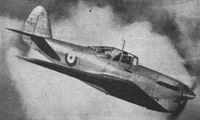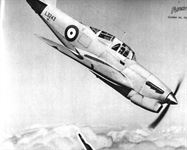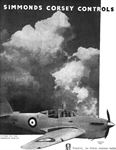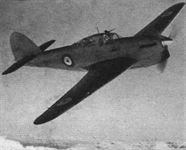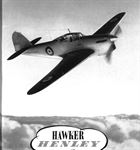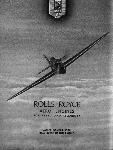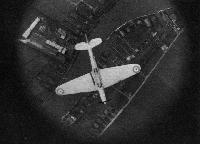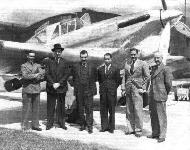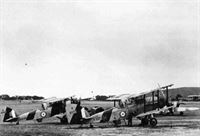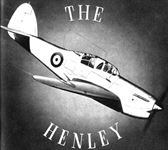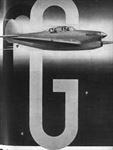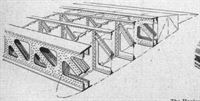
Варианты
- Hawker - Henley - 1937 - Великобритания
- Hawker - Hotspur - 1938 - Великобритания
Henley
Hawker Henley
Техническое задание Министерства авиации P.4/34, выпущенное в феврале 1934 года, содержало требования к легкому бомбардировщику, который бы мог также использоваться в качестве штурмовика. Оговаривались высокие летные характеристики самолета, включая максимальную скорость в 483 км/ч. Учитывая высокие требования к летным качествам и относительно небольшую бомбовую нагрузку, конструкторы компании "Hawker" сочли логичным сделать новый самолет по размерам близким к истребителю Hurricane, который в то время уже находился на завершающем этапе разработки, и заимствование некоторых узлов давало не только экономию средств, но и позволяло упростить подготовку производства. Поэтому Henley, как назвали новую машину, имел хвостовое оперение и внешние части консолей крыла, как у Hurricane, но у него отсутствовали четыре пулемета истребителя. Несмотря на разницу в размерах между Hurricane и Henley, двигатель Rolls-Royce Merlin истребителя был выбран и для установки на легкий бомбардировщик.
Henley представлял собой среднеплан, у которого под крылом был организован бомбоотсек, вмещавший до 249 кг вооружения. Henley имел вторую кабину для наблюдателя/стрелка оснащенную подвижным 7,7-мм пулеметом Lewis; еще один неподвижный 7,7-мм пулемет Vickers был установлен в крыле.
Постройка прототипа началась в середине 1935 года, но легкий бомбардировщик Henley Mk I с двигателем Merlin "F" поднялся в воздух лишь 10 марта 1937 года. Позднее прототип получил новые внешние части консолей крыла, введенные на Hurricane, у которых полотняную обшивку заменили на металлическую. Кроме того, был установлен двигатель Merlin I. Последующие испытания показали, что Henley имеет великолепные летные характеристики. Но в тот момент Министерство авиации решило, что уже не нуждается в легком бомбардировщике, и Henley пошел в серию как буксировщик мишеней. В общей сложности 200 самолетов были построены по субконтракту фирмой "Gloster Aircraft".
Второй прототип Henley Mk II с двигателем Merlin II был соответствующим образом доработан и совершил первый полет 26 мая 1938 года. От предшественника он отличался наличием буксировочной лебедки с приводом от ветряка.
Получившие обозначение Henley Mk III, серийные самолеты поступили в 1-ю, 5-ю и 10-ю школы бомбардиров и стрелков, а также в школы воздушных стрелков в Бэрроу и Сквайэ-Гейте. Тогда и обнаружилось, что, хотя скорость буксировки мишеней была мала, опасность выхода из строя двигателя остается большой. Henley переориентировали на решение еще менее подходящих задач - буксировки больших мишеней для подготовки зенитчиков. Неудивительно, что отказы двигателей стали более частыми, и было потеряно несколько самолетов. Ситуацию удалось исправить лишь в середине 1942 года, когда Henley сняли с вооружения, заменив на Boulton Paul Defiant и Miles Martinet.
ТАКТИКО-ТЕХНИЧЕСКИЕ ХАРАКТЕРИСТИКИ
Hawker Henley Mk III
Тип: двухместный буксировщик мишеней
Силовая установка: один V-образный рядный двигатель Rolls-Royce Merlin II или III мощностью 1030 л. с. (768 кВт)
Летные характеристики: максимальная скорость с целью для воздушных стрелков - 438 км/ч и 322 км/ч с целью для зенитчиков; время набора высоты 6095 м-22 мин 30 с; потолок 8230 м; дальность полета 1529 км
Масса: пустого 2726 кг; максимальная взлетная 3846 кг
Размеры: размах крыла 14,59 м; длина 11,10 м; высота 4,46 м; площадь крыла 31,77 м2
Описание:
- Henley
- Flight, November 1939
Britain's Military Aircraft
Фотографии
-
Aeroplane Monthly 1985-09 / A.Lumsden, T.Heffernan - Probe Probare (16)
Регистрационный номер: K5115 [16] The photograph emphasises the Henley’s corpulent profile and complex cockpit glazing. This aircraft was used as a Rolls-Royce Vulture testbed before being finally struck off charge on March 25, 1941.
-
Flight 1937-04 / Flight
Регистрационный номер: K5115 [16] HASTY HAWKER: The data obtained on initial test flights by the Hawker pilots are secret, but observers at Brooklands are not finding it necessary to line up the new Hawker "P.4" light bomber between two points in order to detect movement. This Flight photograph shows how the Hawker technicians have strived to suppress parasitic excrescences.
-
Flight 1937-11 / Flight
Регистрационный номер: K5115 [16] The Hawker Henley light bomber (Specification P.4/34) is powered with the Rolls-Royce Merlin II and carries its main bomb load in ventral compartments. Additional bombs may be attached outboard.
-
Flight 1940-03 / Flight
Dive-bombers. Hawker Henley two-seater (Gt. Britain). The Henley has internal bomb stowage, though additional bombs may be carried under the wings.
-
Мировая Авиация 152
Регистрационный номер: L3243 [12] При создании Henley использовался ряд элементов истребителя Hurricane. Недостаточный поток воздуха, проходивший через радиатор при малой скорости буксировки мишеней, приводил к перегреву и отказам двигателя Merlin.
-
Aeroplane Monthly 1985-03 / L.Coombs - The expanding years 1936-1939 (5)
Регистрационный номер: L3243 [12] Henley entered service in 1939 as a target tower.
-
Flight 1938-10 / Flight
Регистрационный номер: L3243 [12] TUG O' WAR: High-speed towing of drogue targets is the chief duty of the new Hawker Henley (Rolls-Royce Merlin) shown in this special Flight photograph.
-
Flight 1939-03 / Flight
Регистрационный номер: L3243 [12] Although employed by the R.A.F. on target-towing duties, the Hawker Henley is one of the world’s finest single-engined bombers.
-
Aeroplane Monthly 1993-09 / Personal album. Military
Регистрационный номер: L3261 [2] Hawker Henley III L3261, one of a batch of 200 delivered by Gloster Aircraft between November 1938 and September 1940. Delivered to 3 Armament Training Station, it was later transferred to 1 ATS. On July 18, 1939 the Henley stalled on the approach to RAF Catfoss, near Beverley, Yorkshire, the home of 1 ATS.
-
Flight 1938-05 / Flight
Регистрационный номер: K5115 [16] Adopted for high-speed target towing, the Hawker Henley has a Rolls-Royce Merlin engine.
-
Flight 1939-06 / Flight Advertisements
Регистрационный номер: L3261 [2] -
Aeroplane Monthly 1985-09 / A.Lumsden, T.Heffernan - Probe Probare (16)
Регистрационный номер: K5115 [16] P.4/34 PROTOTYPE: Hawker's answer to an Air Ministry request for a high-speed light bomber. The engine is a Rolls-Royce Merlin which, as will be noted, has the new type of combined glycol radiator, oil-cooler and air intake. New streamlined exhaust collectors are also incorporated. The cockpit enclosure is one of the neatest of its kind yet seen. Brooklands Track will be recognised below.
A fine shot of the Hawker Henley prototype K5115 with Brooklands mapped out below in 1937, note the sewage works on the port wing tip.
The first prototype Henley, K5115. Powered by a Rolls-Royce Merlin F, the aircraft made its first flight on March 10, 1937 from Brooklands. -
Flight 1937-04 / Flight
NEW GENERATION: This exclusive Flight photograph of the production-type Hawker Hurricane single-seater fighter and the "P.4" two-seater bomber in company near Brooklands anticipates the spectacles of formations of such impressive aeroplanes when, in the not-far-distant future, they are in service with the R.A.F. The Hurricane, which, like its flight companion, mounts the Rolls-Royce Merlin, has already been ordered in quantity. Flt. Lt. Bulman's homely headgear in this picture is a tribute to the civilising influence of the modern enclosed cockpit.
Другие самолёты на фотографии: Hawker Hurricane - Великобритания - 1935
-
Flight 1937-12 / Flight
The Hawker P4/34, or Henley (behind the Hurricane), with Rolls-Royce Merlin engine.
Другие самолёты на фотографии: Hawker Hurricane - Великобритания - 1935
-
Aeroplane Monthly 2000-02 / Millenium moments /Unforgettable events/
Регистрационный номер: K5115 [16] Prototypes of the Hurricane and Henley formate, illustrating John Hayward’s memory of the former at North Weald in 1937 - his first air display and traffic jam!
Другие самолёты на фотографии: Hawker Hurricane - Великобритания - 1935
-
Jane's All the World Aircraft 1980 / Encyclopedia of Aviation - Aircraft A-Z - v3
Регистрационный номер: L3243 [12] Hawker Henley.
-
Flight 1940-12 / Flight
Регистрационный номер: L3243 [12] Originally designed to the P.4/34 specification, the Henley (Merlin) shown here was converted for high-speed target-towing, a somewhat wasteful use of a very fine aeroplane
-
Flight 1938-10 / Flight Advertisements
Регистрационный номер: L3243 [12] -
Aeroplane Monthly 1985-09 / A.Lumsden, T.Heffernan - Probe Probare (16)
Регистрационный номер: K5115 [16] This plan view of K5115 shows the Henley's similarity to the Hurricane: it utilised the fighter's outer wing panels and tailplane.
-
Flight 1938-10 / Flight
TUG O' WAR: High-speed towing of drogue targets is the chief duty of the new Hawker Henley (Rolls-Royce Merlin) shown in this special Flight photograph. The drogue cable is wound on a winch driven by a windmill, which can be seen in its out-of-action position, turned edge-on to the slipstream.
-
Flight 1937-04 / Flight
PEEPING ON A "P.4": The camera hole of a Swordfish and the accommodating piloting of Flt. Lt. Christopher Staniland offered Flights photographer this irresistible "shot" of the Fairey P.4/32 high-speed light bomber now undergoing contractor's trials at Heath Row.
-
Aeroplane Monthly 1985-09 / A.Lumsden, T.Heffernan - Probe Probare (16)
Регистрационный номер: K5115 [16] K5115 caught by Flight’s photographer in 1937 with its flaps and undercarriage down.
-
Flight 1937-03 / Flight
Регистрационный номер: K5115 [16] FOR RAPID RAIDS: The Hawker light bomber with 1,000 h.p. - plus Rolls-Royce Merlin engine. There is a marked resemblance to the Hurricane. Points to note are the "belly" for the bombs and the D.H. v.p. airscrew.
-
Aeroplane Monthly 1985-09 / A.Lumsden, T.Heffernan - Probe Probare (16)
Регистрационный номер: K5115 [16] -
Jane's All the World Aircraft 1938 / 03 - All the world's aeroplanes
The Hawker "Henley" Two-seat Day Bomber and Target-Towing Monoplane (Rolls-Royce "Merlin" engine).
-
Flight 1937-03 / Flight
THE MERLIN'S PERCH: A close-up of the installation of the ethylene-glycol-cooled Rolls-Royce Merlin in the Hawker light bomber, revealing also the radiator intake and outlet, bomb traps and details of the Dowty retractable undercarriage with its toed-out Dunlop wheels. It will be noted that the new Rolls-Royce exhaust system, which does a certain amount of flame damping and silencing, is fitted. This offers considerably less resistance than the "ramshorns" used on several Kestrel-engined service types.
-
Flight 1937-06 / Flight
AMBASSADORIAL APPROVAL: Last week, H. E. Alfifi Pasha, the Egyptian Ambassador, visited Brooklands to see the Hawker P.4 and the Miles Magister, the latter having been brought over from Reading. In this group, left to right, are Flt. Lt. P. G. Lucas, Capt. Tait Bey, H. E. Alfifi Pasha, Capt. Nagi, Capt. Razik and Flt. Lt. P. W. S. Bulman. The Hawker P.4 is behind.
-
Flight 1939-07 / Flight Advertisements
Mr. Jerry Sayer (Right) Chief Test Pilot, Mr. Maurice Summers of the Gloster Aircraft Co. Ltd., with a Hawker Henley.
-
Aeroplane Monthly 1993-09 / Personal album. Military
Регистрационный номер: L3274 Gloster-built Hawker Henley L3274 at Hucclecote, where 200 Henleys were built from October 1938.
-
Flight 1937-04 / Flight
THE CRITICS: The Hawker staff at Brooklands have groomed enough thoroughbreds during the past few years to know a good aeroplane when they see one From "George" Bulman downwards the general opinion seems to be that the "P.4" light bomber will deliver the goods in true Hawker abundance.
-
Flight 1939-07 / Flight
Finally comes a comparatively modern Merlin installation in the Hawker Henley.
-
Flight 1937-07 / Flight
Регистрационный номер: K5115 [16] A Hawker pair that aroused much interest, particularly among the foreign visitors - the P.4/34, or Henley, and (hiding behind it) the Hurricane. The Henley light bomber has been adopted by the Air Ministry.
Другие самолёты на фотографии: Hawker Hurricane - Великобритания - 1935
-
Aeroplane Monthly 1985-07 / P.Capon - Capon's Corner
Регистрационный номер: K5115 [16] The prototype Hawker Henley, K5115, outside the Hawker flight sheds at Brooklands in March 1937. Powered by a 1,025 h.p. Rolls-Royce Merlin F engine, this aircraft Later became the Rolls-Royce Vulture testbed. It was struck off charge in March 1941.
-
Aviation Historian 29 / G.Baughen - 1939. Was the RAF ready to war?
Регистрационный номер: K5115 [16] The Hawker Henley, built to Specification P.4/34 for a high-speed monoplane light day bomber, was closely related structurally to its stablemate the Hurricane, and was essentially designed to bomb Paris. It was only ever used as a target-tug, however.
-
Flight 1937-12 / Flight
Ventral bomb stowage, ducted glycol radiator and a neat cockpit enclosure are features of the mid-wing Hawker Henley light bomber adopted during 1937 as a standard Service type.
-
Flight 1938-06 / Flight
Регистрационный номер: K7554 The Hawker Henley bomber as modified for high-speed target towing. Armament Training Stations will shortly be issued with these machines. The engine is a Merlin.
-
Flight 1938-06 / Flight
The Hawker Henley bomber as modified for high-speed target towing. Armament Training Stations will shortly be issued with these machines. The engine is a Merlin.
-
Air-Britain Aeromilitaria 1988-03
Регистрационный номер: L3247 Henley target tug L3247 was serving with No.3 Armament Training Station at Sutton Bridge when this photograph was taken in August 1939. Already the hangar has camouflage screens and there is an anti-gas patch on top of the fuselage of the Henley.
-
Air-Britain Aeromilitaria 1983-02
Регистрационный номер: L3243 [12] Another view of L3243, showing the target-towing gear.
-
Air-Britain Aeromilitaria 1983-02
Регистрационный номер: L3243 [12] -
Aeroplane Monthly 1985-09 / A.Lumsden, T.Heffernan - Probe Probare (16)
Регистрационный номер: L3243 [12] The photographs show Henley L3243, which underwent trials at Boscombe Down from November 1938 to August 1939. It was fitted with a 1,030 h.p. Merlin II engine, and was equipped for target towing.
-
Air-Britain Aeromilitaria 1983-02
Регистрационный номер: L3243 [12] -
Air-Britain Aeromilitaria 1983-02
Регистрационный номер: L3243 [12] -
Aeroplane Monthly 1985-09 / A.Lumsden, T.Heffernan - Probe Probare (16)
Регистрационный номер: L3276 [2] L3276 with bombs mounted externally outboard of the undercarriage. The aircraft still handled well, though it was recommended that all bombs be dropped before landing.
-
Aeroplane Monthly 1985-09 / A.Lumsden, T.Heffernan - Probe Probare (16)
Регистрационный номер: L3276 [2] Henley L3276 was powered by a Merlin V and underwent trials at A&AEE between February and March 1942, to gauge its performance with towing gear removed and with bombs carried externally. This aircraft had camouflaged upper surfaces and yellow underside, with black diagonal target tug stripes.
-
Air Pictorial 1957-10 / Photos by request
Регистрационный номер: L3414 A production Henley III (L3414), was re-engined with a Rolls-Royce Griffon IIB. Note differences in undercarriage and canopy detail.
-
Aeroplane Monthly 1986-11 / D.Middleton - E.L. "Jock" Bonar /Test Pilot Profile/ (14)
Регистрационный номер: K5115 [16] Hawker Henley K5115 fitted with the 1,760 h.p. Rolls-Royce Vulture engine. To compensate for the extra weight of this engine it was necessary to load 200lb of lead into the tail.
-
Air Pictorial 1957-10 / Photos by request
Регистрационный номер: K5115 [16] Although usually classed as a contemporary of the Fairey Battle, the Hawker Henley was designed to a later specification (P.4/34), which was secured by the Fleet Air Arm development, the Fairey Fulmar. Thus the Henley two-seat light bomber (one 1,030-h.p. Rolls-Royce Merlin II) was relegated to target-towing duties as the TT. Mk. III of 1939. Several Henleys served as flying test-beds: (photo) the all-silver first prototype of 1937 was re-engined with the experimental Rolls-Royce Vulture twenty-four-cylinder X-type motor.
-
Aeroplane Monthly 1986-11 / D.Middleton - E.L. "Jock" Bonar /Test Pilot Profile/ (14)
Регистрационный номер: K5115 [16] Another view of the Vulture-powered Hawker Henley, K5115, on which Bonar flew for 70hr, during which time he experienced two forced landings. K5115 was struck off RAF charge in 1941.
-
Air-Britain Aeromilitaria 1983-03
In 1976, Aeromilitaria had an article on Penrhos airfield but this was in pre-photo days. This was taken in August 1940 at No.9 Bombing & Gunnery School and show the unit's Henley and Wallace target tugs. K6073 actually has a code letter 'H'.
Другие самолёты на фотографии: Westland Wallace / PV.3 / PV.6 - Великобритания - 1931
-
Air-Britain Aeromilitaria 1983-03
Royal Naval Air Station, Hatston, looking east towards Kirkwall. Apart from the line of sixteen Swordfish, visible on the left is a Henley and two Skuas of No.771 Squadron, the Fleet Requirements Unit at Hatston
Другие самолёты на фотографии: Blackburn Skua / B-24 - Великобритания - 1937Fairey Swordfish - Великобритания - 1934
-
Air-Britain Aeromilitaria 1983-03
Martlet AX829 soon after arriving at Hatston as the first replacement aircraft for the Sea Gladiators, one of which can be seen on the left of Hatston's watch office. In the background can be seen Swordfish and a Henley of the Fleet Requirement Unit at Hatston. On the right is the airfield's Chance light mounted on a chassis.
Другие самолёты на фотографии: Fairey Swordfish - Великобритания - 1934Gloster Sea Gladiator - Великобритания - 1938Grumman F4F Wildcat - США - 1937
-
Aeroplane Monthly 1999-11 / T.Hall - Cutaway Kings: Peter Endsleigh Castle /Cutaway drawings/
These 1/24-scale models of the Hawker Henley (top) and Hurricane were made for the Glasgow and Toronto exhibitions of 1937-38, when Peter was a draughtsman and modeller with the Model Transport Company.
Другие самолёты на фотографии: Hawker Hurricane - Великобритания - 1935
-
Flight 1940-02 / Flight
The Henley (shown) and Northrop wings are examples of multi-spar construction. This form does not lend itself readily to installation of loads and equipment in the wing.
-
Flight 1937-07 / Flight
The Hawker Henley's cockpit enclosure. Internal bracing protects the pilot in the event of a noseover.
-
Flight 1940-01 / Flight
FAIREY P.4/34 (Great Britain) A fast light bomber smaller than the Battle
BLACKBURN SKUA (Great Britain) In service with Fleet Air Arm
JUNKERS Ju 87 (Germany) In service with German Air Force
HAWKER HENLEY (Great Britain) Built to same specification as Fairey P.4/34
VOUGHT SB2U-1 (V-156) (America) In service with US Navy
FOKKER G.1 (Holland) A variant of a multi-purpose design
SUPERMARINE Type 224 (Great Britain)
PZL WILK (Wolf) (Poland) Designed as a fighter dive-bomber for the Polish Air Force
BREWSTER XSBA-1 (Model 138) (America) In production at Naval Aircraft Factory Philadelphia
CURTISS SBC-4 (Helldiver 77) (America) In service with US Navy
BELL BG-1 (America) Developed from a type used by US Marines
DOUGLAS DB-19 (America) A Northrop design in service with US Navy
LOIRE NIEUPORT L.N.40 (France) In service with French Navy
SAVOIA MARCHETTI S.M.85 (Italy) In service with Italian Air ForceДругие самолёты на фотографии: Blackburn Skua / B-24 - Великобритания - 1937Brewster SBA / SBN / B-38 - США - 1936Curtiss SBC Helldiver - США - 1934Fairey Fulmar / P.4/34 - Великобритания - 1937Fokker G.I Le Faucheur - Нидерланды - 1937Great Lakes BG-1 - США - 1933Junkers Ju.87B - Германия - 1938Loire-Nieuport LN 401/411 - Франция - 1938Northrop BT - США - 1935PZL P.38 Wilk - Польша - 1938Savoia-Marchetti / SIAI SM.85 - Италия - 1936Supermarine Type 224 - Великобритания - 1931Vought SB2U Vindicator / V-156 - США - 1936
-
Air-Britain Aeromilitaria 1975-01
Hawker Henley III: Prototype; Vulture test-bed; Griffon test-bed
-
Air-Britain Aeromilitaria 1975-01
Hawker Henley III. L3363 in standard camouflage, dark earth/dark green top, yellow/black under (stripes at 30). Wind-operated winch shown in winding-in position
- Фотографии




